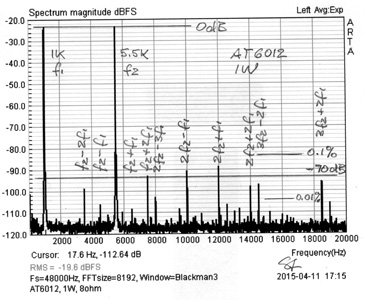|
For many years I have been using ATI power amplifiers. In
their product line the 12-channel AT6012 power amplifier is well suited to the
LXstudio. Each driver would have its own 60 W stereo amplifier, which can
provide as much peak current or peak voltage as I would ever want in my 100 m3
listening room at The Sea Ranch.
The AT6012 is rated at 60 W per
channel into 8
ohm FTC full bandwidth output power, with all 12 channels driven simultaneously.
The power supply has high current reserve and a 2000 VA transformer. A pair of
LXstudio speakers utilizes 8 amplifiers, which leaves 4
amplifiers for any future use, for example the LX521.4, which would take 10
amplifiers. A separate amplifier channel is allocated
to each of the 10" dipole woofer drivers to obtain output capability that is
commensurate with the midrange, yet minimizes bottoming and the risk of
mechanical damage to the woofers, or having to reduce the speaker's low
frequency extension. At very high sound levels the amplifiers clip first, which
gives a clearly audible warning to turn down the volume.
 |
 |
The AT6012 exhibits good low power intermodulation
distortion performance as seen in the graphs above. It is primarily 3rd order at
1 W in response to equal amplitude input signals at 1 kHz and 5.5 kHz driving an
8 ohm resistor. Harmonic distortion products are always of lower amplitude than
intermodulation products. Unlike for many Class A/B amplifiers the distortion
does not increase as power goes down. A 100 mW output level is not unrealistic.
Early transistor radios had 50 mW output stages and made quite a bit of noise.
The AT1806
is a six-channel power amplifier rated at 180 W per channel. It can drive the
LXstudio, if the two 10" drivers in each woofer baffle are connected in
parallel to one amplifier. The parallel drivers
present a low 2 ohm impedance to the power amplifier around 100 Hz. The power
amplifier driving this load must be capable of at least 200 W into 4 ohm.
The AT1806 is capable of
producing higher bass output volume from the LXstudio than the AT6012 and handle
extreme loudness peaks. The DSP crossover/equalizer requires no
modification for its use.
But, the higher power has the potential to bottom out and damage the woofers below 40 Hz and to overheat
or stress LXmini woofer/midrange and
tweeter with high level test or transient signals. I never had a failure with
program material even at extreme volume levels.
The intermodulation distortion performance of the AT1806
at low power levels is exemplary.
The AT1202 is a two-channel power amplifier rated at 120 W per
channel. It would be needed to drive left and right LXmini tweeters, if
the AT1806 powers each dipole woofer driver individually and also the
LXmini woofer/midrange drivers. The AT1202 is a little safer for the LXmini
tweeter than the AT1806. In any case caution is advised with such high power
amplifier setup.
The intermodulation distortion performance of the AT1202
at low power levels is very good.
Note that my power description is for peak voltage
equivalent power. A 2 Vpeak sinewave at 1 kHz and a 2 Vpeak sinewave at 5.5 kHz
superimpose and fluctuate at a 4.5 kHz rate as seen on an oscilloscope. The
fluctuation has 4 Vpeak amplitude, which I call equivalent to "1 W"
for the conventional single frequency sinusoid of 4 Vpeak or 2.83 Vrms across 8
ohm. Similarly the "100 mW" description is for 1.26 Vpeak of the
superimposed sinusoids. The actual dissipated powers are 500 mW and 50 mW into 8
ohm.
Harmonic distortion products are below 0.01% for the three amplifiers measured.
But musical signals are rarely single sinusoids. Intermodulation distortions are
always higher than harmonic distortions and their spectral distribution is in my
opinion a better differentiator between amplifiers than a single harmonic
distortion number.
ATI making an amplifier -- ATI sales story
|